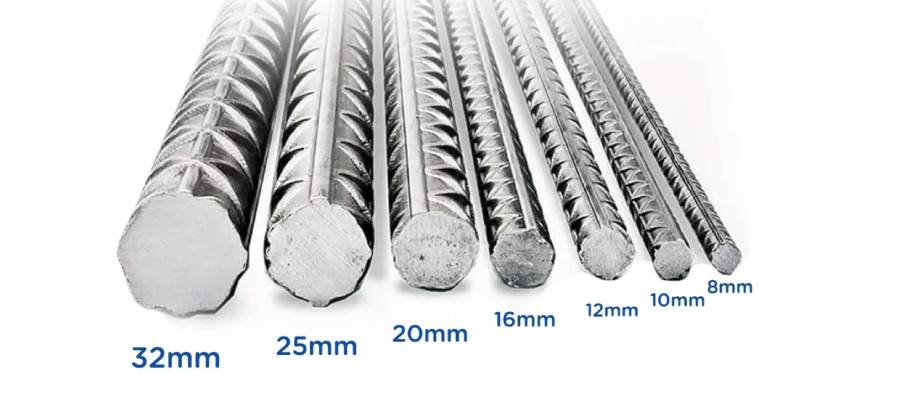#3 to #18 Steel Rebar Sizes: Uses, Specifications & selection recommendations
Rebar (reinforcement steel) is a critical component in building construction, providing tensile strength to concrete and building structures. Choosing the right rebar size ensures structural integrity and cost-effectiveness. This guide covers the sizes, specifications, applications, and selection recommendations for gauges 3 to 18, aiming to help engineers and contractors make informed decisions.
What are the sizes of steel rebars?
Steel Rebar sizes are designated by numbers (#3, #4, #5, etc.), which correspond to their diameter in 1/8-inch increments. For example:
#3 rebar = 3/8-inch diameter
#6 rebar = 6/8-inch (3/4-inch) diameter
#18 rebar = 18/8-inch (2.25-inch) diameter
Metric equivalents (e.g., 10M, 20M) are also used in some regions, but this guide focuses on US standard sizes (#3 to #18).
Steel Rebar Size Chart (#3 to #18)
Below is a detailed rebar size chart with diameter, weight, and cross-sectional area:
| Rebar Size (#) | Diameter (inches) | Diameter (mm) | Weight (lb/ft) | Weight (kg/m) | Area (in²) |
|---|---|---|---|---|---|
| #3 | 0.375" | 9.5 mm | 0.376 | 0.560 | 0.11 |
| #4 | 0.500" | 12.7 mm | 0.668 | 0.994 | 0.20 |
| #5 | 0.625" | 15.9 mm | 1.043 | 1.552 | 0.31 |
| #6 | 0.750" | 19.1 mm | 1.502 | 2.235 | 0.44 |
| #7 | 0.875" | 22.2 mm | 2.044 | 3.042 | 0.60 |
| #8 | 1.000" | 25.4 mm | 2.670 | 3.973 | 0.79 |
| #9 | 1.128" | 28.7 mm | 3.400 | 5.060 | 1.00 |
| #10 | 1.270" | 32.3 mm | 4.303 | 6.404 | 1.27 |
| #11 | 1.410" | 35.8 mm | 5.313 | 7.907 | 1.56 |
| #14 | 1.693" | 43.0 mm | 7.650 | 11.38 | 2.25 |
| #18 | 2.257" | 57.3 mm | 13.60 | 20.24 | 4.00 |
*(Note: #12, #13, #15, #16, and #17 are less common and often custom-ordered.)*
Need rebar? Check out our [Steel rebar] for high-quality products in a wide range of sizes. Contact us today!
Steel Rebar Spacing Guidelines
Proper rebar spacing ensures structural strength and prevents cracking. General recommendations:
Slabs & Footings:
#3 to #5 rebar, spaced 12" to 18" apart
Walls & Columns:
#4 to #6 rebar, spaced 6" to 12" apart
Beams & Heavy Loads:
#6 to #11 rebar, spaced 4" to 8" apart
Rule of Thumb: Larger rebar = wider spacing, smaller rebar = closer spacing.
Common Uses for #3 to #18 Rebar
| Rebar Size | Typical Applications |
|---|---|
| #3 - #4 | Light-duty slabs, sidewalks, patios, pool decks |
| #5 - #6 | Driveways, foundations, retaining walls, small beams |
| #7 - #9 | Bridges, heavy foundations, large beams, parking structures |
| #10 - #11 | High-rise buildings, industrial structures, seismic zones |
| #14 - #18 | Mega-projects (dams, nuclear plants, skyscrapers) |

How to Choose the Right Steel Rebar Sizes?
Consider these factors:
✅Load Requirements – Heavier loads need thicker rebar (#8+).
✅Concrete Thickness – Rebar should be 1/8 to 1/4 of slab thickness.
✅Spacing Needs – Closer spacing may allow smaller rebar.
✅Building Codes – Always follow ACI 318 or local regulations.
Pro Tip: For most residential projects, #4 to #6 rebar is sufficient. Large-scale projects require #7 and above.
FAQs About Steel Rebar Sizes
Q: What does the "#" mean in rebar sizes?
A: The number represents 1/8-inch increments of diameter (e.g., #5 = 5/8").
Q: Can I mix rebar sizes in a project?
A: Yes, but follow engineering specs—larger bars for main support, smaller for secondary reinforcement.
Q: What’s the difference between #5 and #6 rebar?
A: #6 is thicker (3/4" vs. 5/8") and carries ~44% more load capacity.
Q: Is #18 rebar used in residential construction?
A: Rarely—it’s mostly for heavy civil engineering (bridges, dams).
Choosing the right rebar size is crucial for structural safety and efficiency. Smaller bars (3-6 gauge) are suitable for lighter projects, while larger bars (7-18 gauge) are ideal for heavier construction. For critical projects, you can consult with our expert engineers.
RELATED INFORMATION
Rebar prices are expected to continue the trend of wide range oscillation
2025-03-25
Vale to Use World's First Iron Ore Briquetting Plant in Brazil
2025-04-02
2025-04-05







